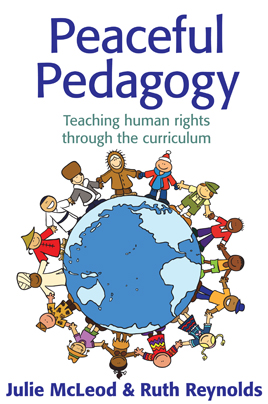The Book
Peaceful Pedagogy sets out a way for every classroom and every school to become a peace-building place. It presents a pedagogical model for learning about, through and for human rights so that children can know, experience and enact human rights and responsibilities to create the conditions conducive to peace, whether at an interpersonal, intergroup, national or international level (UNICEF Peace Education 2009).
It supports teachers in planning a values-based human rights curriculum for the essential learnings in literacy and numeracy, and important life skills such as critical thinking, decision-making, communication, negotiation, conflict resolution, coping, and self-management (UNICEF Peace Education 2009) and demonstrates through case studies how children learn to enact ‘peace’ locally, bringing about constructive change, through issues that are both local and global.
The Authors
Julie McLeod (PhD, MEd, BA, Dip Teach) is the convenor of Primary Teacher Education at the University of Newcastle. Her research interests lie in linking schools and their communities and she is currently consulting with schools to help them research and develop ABEL environments (Asset Based Engaged Learning) to support students’ education through engagement with their cultures and communities.
Ruth Reynolds (PhD, BA Hons Psychology, B. Social Science, Dip Ed.) is a Senior Lecturer at the University of Newcastle and is program convenor of the M. Teach (Primary) program. She has published extensively on issues associated with HSIE/SOSE education in early childhood, primary and secondary fields with particular emphasis on history and geography education and citizenship.
Contents
Chapter 1: Educating for peace
Reviews recent movements for peace education, guided by structures such as UNICEF programs, the Millennium Development goals and human rights principles from the Convention on the Rights of the Child. It examines values as foundation for human rights and peace education in line with the Education for All (EFA) Dakar Framework of Action which calls for the promotion of an education that helps children and young people to acquire skills such as the prevention and resolution of conflicts as well as social and ethical values.
Chapter 2: A curriculum for peaceful learning: Planning for peaceful learning through human rights
Proposes a model for a curriculum that educates for peace through a model of curriculum where ‘human rights are taught through both content transmission and experiences’ (UNESCO Statement of Values, 2000). This curriculum model demonstrates how educating for peace through human rights can become the focus of classroom learning and teaching while working within the content and learning expectations of mandated syllabus.
Chapter 3: A pedagogy for peaceful learning: Implementing peaceful learning through human rights
Describes the pedagogy to enact the ‘peaceful’ curriculum outlined in Chapter 2. A series of ‘frameworks’ are proposed that develop the knowledge, skills, attitudes and values needed for peace at an interpersonal, intergroup, national or international level.
| Chapters 4-9 present case studies from different schools where peaceful pedagogy is being enacted through different curricula frameworks through which students learn the ‘peace-making’ life skills identified by UNICEF: critical thinking, decision-making, communication, negotiation, conflict resolution, coping, and self-management (UNICEF Peace Education 2009) while addressing an issue in their learning context which has direct links to an article from the UN Declaration of the Rights of the Child. |
Chapter 4: Thinking for peace
Outlines a framework where learners develop critical thinking skills while engaging with the content and processes of the curriculum. Within this framework children use metacognitive strategies to critically analyse, learn about, and act on an issue. The case study in this chapter presents a cognitive taxonomy developed collaboratively by an Aboriginal community and its school to address social issues in the community and applied to children’s learning across the curriculum.
Chapter 5: Investigating for peace
Outlines a framework where learners develop skills in conflict resolution through the research process into an issue of their learning context. Designing questions for research is a key skill that is developed. As they investigate an issue, students also investigate themselves – their talents, their ways of learning, their ability to react with stimuli in different ways. The case study in this chapter presents a research structure developed by a local school to investigate the social impact of holiday visitors on the community.
Chapter 6: Managing ourselves for peace
Outlines a framework where learners develop skills in self-management and coping to enable them to interact and co-operate with others. The case study in this chapter presents a program where behaviourally challenged students were teamed with developmentally delayed students in cooperative learning situations.
Chapter 7: Communicating for peace
Outlines a framework where learners develop skills in communication that enable them to relate with others through the different modes of literacy that are available. The case study in this chapter presents an intergenerational, multilingual interaction between a school and its community.
Chapter 8: Negotiating decisions for peace
Outlines a framework where learners develop skills in negotiating and decision-making through engaging with groups in the wider community. The case study in this chapter demonstrates how a group of students can take responsibility for an element of their physical environment which impacts on the whole community.
Chapter 9: Global perspectives for peace
Explores the opportunities for students to apply knowledge, skills, understanding and values developed from local contexts to the global, and from short term to long term perspectives of peace. |
